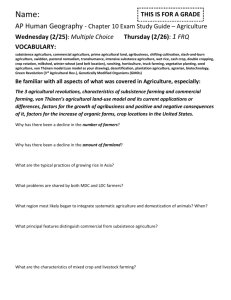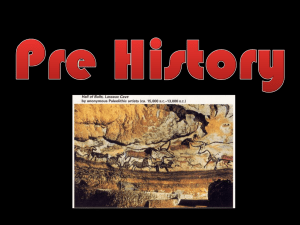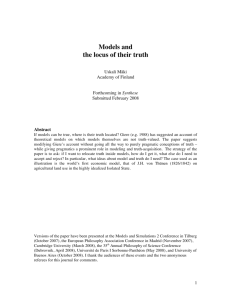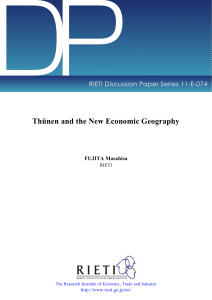ALnotes-HumI3-FarmingLandUseModel
advertisement
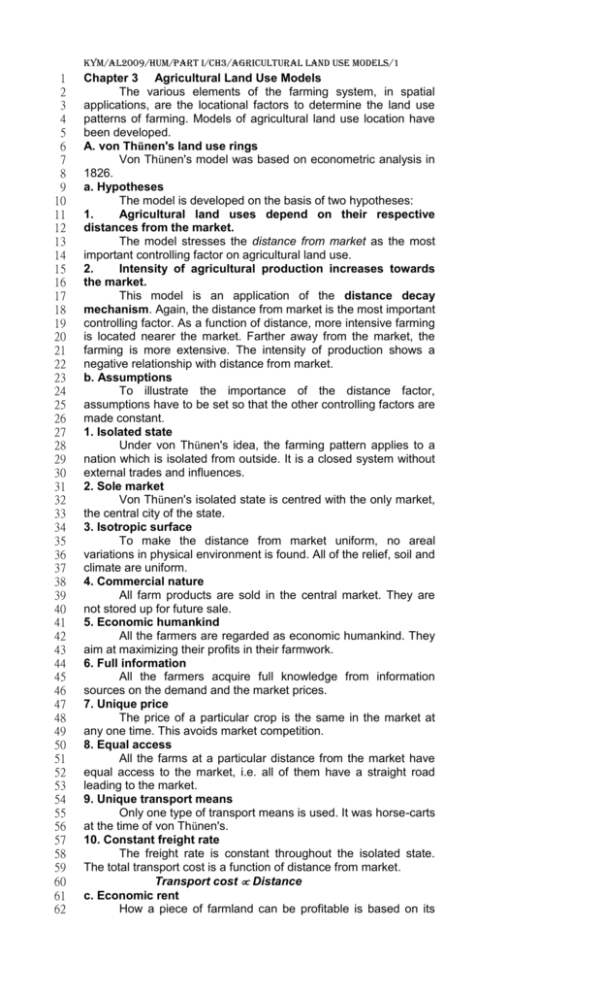
KYM/AL2009/HUM/Part I/Ch3/Agricultural land use models/1 1 2 3 4 5 6 7 8 9 10 11 12 13 14 15 16 17 18 19 20 21 22 23 24 25 26 27 28 29 30 31 32 33 34 35 36 37 38 39 40 41 42 43 44 45 46 47 48 49 50 51 52 53 54 55 56 57 58 59 60 61 62 Chapter 3 Agricultural Land Use Models The various elements of the farming system, in spatial applications, are the locational factors to determine the land use patterns of farming. Models of agricultural land use location have been developed. A. von Thünen's land use rings Von Thünen's model was based on econometric analysis in 1826. a. Hypotheses The model is developed on the basis of two hypotheses: 1. Agricultural land uses depend on their respective distances from the market. The model stresses the distance from market as the most important controlling factor on agricultural land use. 2. Intensity of agricultural production increases towards the market. This model is an application of the distance decay mechanism. Again, the distance from market is the most important controlling factor. As a function of distance, more intensive farming is located nearer the market. Farther away from the market, the farming is more extensive. The intensity of production shows a negative relationship with distance from market. b. Assumptions To illustrate the importance of the distance factor, assumptions have to be set so that the other controlling factors are made constant. 1. Isolated state Under von Thünen's idea, the farming pattern applies to a nation which is isolated from outside. It is a closed system without external trades and influences. 2. Sole market Von Thünen's isolated state is centred with the only market, the central city of the state. 3. Isotropic surface To make the distance from market uniform, no areal variations in physical environment is found. All of the relief, soil and climate are uniform. 4. Commercial nature All farm products are sold in the central market. They are not stored up for future sale. 5. Economic humankind All the farmers are regarded as economic humankind. They aim at maximizing their profits in their farmwork. 6. Full information All the farmers acquire full knowledge from information sources on the demand and the market prices. 7. Unique price The price of a particular crop is the same in the market at any one time. This avoids market competition. 8. Equal access All the farms at a particular distance from the market have equal access to the market, i.e. all of them have a straight road leading to the market. 9. Unique transport means Only one type of transport means is used. It was horse-carts at the time of von Thünen's. 10. Constant freight rate The freight rate is constant throughout the isolated state. The total transport cost is a function of distance from market. Transport cost Distance c. Economic rent How a piece of farmland can be profitable is based on its KYM/AL2009/HUM/Part I/Ch3/Agricultural land use models/2 1 2 3 4 5 6 7 8 economic rent. The term is also known as land rent or locational rent. It is the return that can be obtained from a piece of farmland over which can be obtained from the land at the margin of economic cultivation. As distance from market is the only variable in the model: E = Y(p-c)-Yfd where E = economic rent Y = yield (amount of production) p = market price per unit of yield c = fixed cost of production per unit of yield f = freight rate d = distance from market (Yfd = total transport cost) Economic rent is also a distance decay function with distance from market. Closer to the market, the economic rent is higher. At the margin of economic cultivation, E = 0. 9 10 11 12 13 14 15 16 17 18 19 20 21 22 23 24 25 1. Market-oriented crops Bulky or perishable crops are market-oriented. Because of their higher freight rates than non-bulky or non-perishable crops, their margin of production is closer to the market. On the other hand, their higher market prices lead them to have a higher economic rent at places near the market. As a result, they are cultivated at locations near the market. 2. Intensity of production With a higher intensity of production, more inputs are devoted into the cropping process. The production cost is thus higher than less intensive one. Although there is a higher yield so that a higher economic rent is obtained, it is in diminishing return. Besides, the total transport cost also increases. The margin of economic production is thus closer to the market. As a result, more intensive production is found nearer the market than the extensive one. 26 27 28 29 30 31 d. Land use rings According to the location of market-oriented crops and intensity of production, von Thünen developed a structure of 6 land use rings to show the concentric zonal pattern of agricultural land use around the central market. KYM/AL2009/HUM/Part I/Ch3/Agricultural land use models/3 1 2 3 4 5 6 7 8 9 10 11 12 13 14 15 16 17 18 19 20 21 22 23 24 25 26 27 1. Free cash cropping This forms the innermost ring. Market gardening and dairying are practised, using town manure. The products are perishable. They should be transported to the market in fresh. 2. Forestry The ring was important at von Thünen's time as firewood was the major fuel. As wood is bulky, it is sited close to the central city. 3. Crop alteration system Arable farming is found. It is very intensive and crop rotation is adopted. At von Thünen's time, the major crop was rye. 4. Improved system The system is less intensive. Mixed farming is adopted, with fields in fallow and pasture. The main crop was also rye. 5. Three-field system The system is extensive. The farm is divided into three broad areas for different extensive cropping. 6. Stock farming This forms the outermost ring. Livestock, chiefly beef cattle or sheep, is reared on natural pasture. e. Criticisms and modifications Von Thünen's model is too simplified and is not applicable to the real world, even in his time. There are many modified cases which are more realistic, as in Hong Kong and New South Wales of Australia. KYM/AL2009/HUM/Part I/Ch3/Agricultural land use models/4 1 2 3 4 5 1. River navigation Rivers should not be omitted in the isolated state. They are important control of farming. Besides, river transport is cheaper than road transport. 6 7 8 9 10 11 12 13 14 15 At von Thünen's time, river transport cost only 10% of that by horse-cart. River transport is especially favourable for the bulky wood. The ring of forestry thus extends along the rivers. 2. Alternative markets There is not only one market in the centre of the isolated state. Minor markets usually occur in the midst of rich farmlands for convenient trading. These markets may be periodic. Later, a small town may appear as a small market town. Another ring structure, though smaller in areal extent, is resulted around this minor market. 16 17 18 19 20 21 22 3. Varied physical environment The isolated state cannot be isotropic. There are variations in physical conditions, either regional or local. Different slopes occur, soils vary in fertility, and both temperature and rainfall are not unique everywhere. Local variations in cropping pattern thus occur. KYM/AL2009/HUM/Part I/Ch3/Agricultural land use models/5 1 2 3 4 If a piece of swampland is present, the land use rings may extend outwards for compensation. 5 6 7 8 9 10 4. Perception Farmers are not perfect economic man. Their own perception and the knowledge are important filters on the choice of crops and livestock. In most cases, their economic rent is not optimal. 11 12 13 14 15 16 5. Tariff Isolated state never exists. Trading with the outside world does happen. In modern times, foreign countries may impose tariff which increases the cost of certain crops. The economic rents of such crops then decrease. 17 18 19 20 6. Tax If tax is imposed on certain agricultural products, the crops may reduce in production area as the production cost is higher. KYM/AL2009/HUM/Part I/Ch3/Agricultural land use models/6 1 2 3 4 5 7. Increased market price When the price of a particular crop increases, the higher revenue from this crop may attract the farmers to devote their land to the cultivation of the crop. Then, the land use zone will expand. 6 7 8 9 8. Drop in market price If the market price of a particular crop drops sharply, its economic rent reduces so that its cropping may be abandoned. 10 11 12 13 14 9. Drop in freight rate If the freight rate of a particular crop is reduced, its total transport cost is lowered. Its cropping area then expands as it is more profitable. 15 16 17 18 19 20 21 22 23 24 25 26 B. Sinclair's model Sinclair model was developed in 1967 as a critique on the traditional von Thünen's model. a. Urban encroachment Sinclair paid special attention to the post-war urban expansion which was common in the developed world. Due to urban growth, farmland around the city fringes will gain a much higher land value. It may finally be encroached for building roads, houses or industrial estates. Farmers will then prefer to wait for selling their farmland for urban development. The value for farming therefore decreases. KYM/AL2009/HUM/Part I/Ch3/Agricultural land use models/7 1 2 3 4 5 Farming close to the city market thus becomes extensive. Besides, many farmers prefer to leave their farmland for the urban life. The rural-urban migration results in loss of farm labour so that farming intensity also decreases, as in the case of Hong Kong. 6 7 8 9 10 11 12 13 14 b. Land use zones The effect of urban growth leads to a reversed pattern in production intensity as that described by von Thünen. The intensity of production now shows a positive relationship with the distance from market. That is to say, farming generally becomes more intensive in locations farther away from the expanding city which is the market. Sinclair developed 5 land use zones: 15 16 17 18 19 20 21 22 23 24 25 26 27 28 29 30 31 32 33 1. Urban farming This forms the innermost zone. Farming here is based on the demand from the urban city. There are greenhouse cultivation and poultry farming. These farming systems are under insecurity. They may be given up immediately when urban encroachment takes effect. 2. Vacant or grazing The land is abandoned and awaiting for urban development. Some land may be rented out for short-term grazing. 3. Field crop and grazing This is extensive farming. Field crops are grown. Some of the land may be used for grazing. 4. Dairying and field crops The farming systems are more intensive. With improved treatment and transport technology, dairying can now be sited far away from the city market. 5. Specialized field grains and livestock Farming in the developed world is now commercial. Farthest KYM/AL2009/HUM/Part I/Ch3/Agricultural land use models/8 1 2 3 4 away from the city market, farming is comparatively most intensive, such as the farming system in the Corn Belt of the USA. Efficient transport allows large-scale commercial farming in such remote areas.
